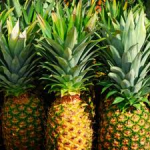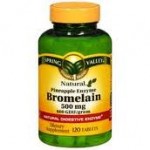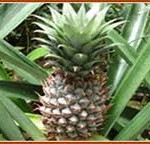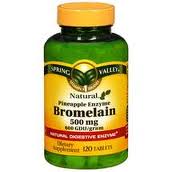Bromelain is extracted from the stems of pineapples. It has a history of folk and modern medicinal use. As a supplement it is thought to have anti-inflammatory effects. As a culinary ingredient it is primarily used as a tenderizer. Bromelain also contains chemicals that might interfere with the growth of tumor cells and slow blood clotting, according to laboratory research.
 The term “bromelain” can refer to either of two protease enzymes extracted from the plant family Bromeliaceae, or it can refer to a combination of those enzymes along with other compounds produced in an extract.
The term “bromelain” can refer to either of two protease enzymes extracted from the plant family Bromeliaceae, or it can refer to a combination of those enzymes along with other compounds produced in an extract.
Extract components
Bromelain extract is a mixture of protein-digesting enzymes—called proteolytic enzymes or proteases and several other substances in smaller quantities. The proteolytic enzymes are referred to as sulfhydryl proteases, since a free sulfhydryl group of a cysteine side-chain is required for function. The two main enzymes are:
- Stem bromelain – EC 3.4.22.32
- Fruit bromelain – EC 3.4.22.33
The other substances typically include peroxidase, acid phosphatase, protease inhibitors, and calcium.
History
The first isolation of bromelain was recorded by the Venezuelan chemist Vicente Marcano (BU1 1.Phar. 5,77) in 1891 from the fruit of pineapple. In 1892, Chittenden, assisted by Joslin and Meara, investigated the matter fully (Trans. Conn. Acad. Arts Sci. 8, 281-308), and called it ‘bromelin’. Later, the term ‘bromelain’ was introduced and originally applied to any protease from any plant member of the plant family Bromeliaceae.
Bromelain was first introduced as a therapeutic supplement in 1957. Research on bromelain was first conducted in Hawaii but more recently has been conducted in countries in Asia, Europe, and Latin America. Germany has recently taken a great interest in bromelain research; bromelain is currently the thirteenth-most-widely-used herbal medicine in Germany.
Source
Bromelain is present in all parts of the pineapple plant (Ananas sp.). However, the stem is the most common commercial source, presumably because it is readily available after the fruit has been harvested. Pineapples have had a long tradition as a medicinal plant among the natives of South and Central America.
Uses
Potential medical uses
 Available in some countries as a product under the name ‘Ananase’, bromelain began its reputation for various uses in folk medicine and continues to be explored as a potential healing agent in alternative medicine. First introduced in medical research in 1957, bromelain may work by blocking some proinflammatory metabolites when applied topically. Bromelain may be used after surgery to reduce swelling. Preliminary research indicates that bromelain may affect migration of neutrophils to sites of acute inflammation. As a potential anti-inflammatory agent, it may be useful for treating arthritis, but has neither been confirmed in human studies for this use nor is it approved with a health claim for such an effect by the Food and Drug Administration or European Food Safety Authority. The Natural Medicines Comprehensive Database suggests that bromelain, when used in conjunction with trypsin and rutin is as effective as some prescription analgesics in the management of osteoarthritis.
Available in some countries as a product under the name ‘Ananase’, bromelain began its reputation for various uses in folk medicine and continues to be explored as a potential healing agent in alternative medicine. First introduced in medical research in 1957, bromelain may work by blocking some proinflammatory metabolites when applied topically. Bromelain may be used after surgery to reduce swelling. Preliminary research indicates that bromelain may affect migration of neutrophils to sites of acute inflammation. As a potential anti-inflammatory agent, it may be useful for treating arthritis, but has neither been confirmed in human studies for this use nor is it approved with a health claim for such an effect by the Food and Drug Administration or European Food Safety Authority. The Natural Medicines Comprehensive Database suggests that bromelain, when used in conjunction with trypsin and rutin is as effective as some prescription analgesics in the management of osteoarthritis.
Bromelain may also be used for a variety of other effects that remain scientifically unconfirmed and not authorized by regulatory authorities like the Food and Drug Administration. These may include: hay fever, treating a bowel condition that includes swelling and ulcers ulcerative colitis, removing dead and damaged tissue after a burn debridement, preventing the collection of water in the lung pulmonary edema, relaxing muscles, stimulating muscle contractions, slowing clotting, improving the absorption of antibiotics, preventing cancer, shortening labor, and helping the body get rid of fat.
Systemic enzyme therapy (consisting of combinations of proteolytic enzymes such as bromelain, trypsin, chymotrypsin, and papain) has been investigated in Europe to evaluate the efficacy of proteolytic enzymes in the treatment of breast, colorectal, and plasmacytoma cancer patients. In mice with experimental colitis, 6 months of dietary bromelain from pineapple stem or from fresh juice decreased the severity of colonic inflammation and reduced the number of cancerous lesions in the colon.
As bromelain supplementation may affect heart rate, care should be used by those with heart disease.
Meat tenderizing
Along with papain, bromelain is one of the most popular substances to use for meat tenderizing.
Today, about 90% of meat tenderizer is used in consumer households. Bromelain is sold in a powdered form, which is combined with a marinade, or directly sprinkled on the uncooked meat. The enzyme will penetrate the meat and, by a process called forking, cause the meat to be tender and palatable when cooked. If the enzyme is allowed to work for too long, the meat may become too “mushy” for many consumers’ preferences. Cooked or canned pineapple does not have a tenderizing effect, as the enzymes are heat-labile.
Some prepared meat products, such as meatballs, and commercially available marinades include pineapple and/or pineapple-derived ingredients.
Apart from the mushiness of meat that has been over-tenderized, the activity of bromelain and similarly proteolytic plant enzymes can be undesirable where it is inappropriate. In dishes that depend on their protein content for important attributes, uncooked pineapple or its juice can be a nuisance. For example, some dishes such as brawn and jelly rely on the setting of gelatin. They will not set if they contain raw pineapple or pineapple juice. Raw figs, papaya, and similarly proteolytic vegetable matter causes similar problems. To prevent the problem, the fruit should first be cooked, or at least parboiled sufficiently to inactivate the enzymes. In general, thorough heating to above about 65 degrees C will suffice. This problem does not affect dishes based on non-proteinaceaous gelling agents, such as agar, though such agents may be prevented from gelling by too much heating in acid recipes.
Bromelain prefers to cleave at Lys-, Ala-, Tyr-, Gly-. Is activated by cysteine, bisulfite salt, NaCN, H2S, Na2S, and benzoate. It is inhibited by Hg++, Ag+, Cu++, a-1-antitrypsin, estatin A&B, Iodoacetate, TLCK, TPCK
Pharmacodynamics
 Bromelain, increases blood fibrinolytic activity as well as inhibiting fibrinogen synthesis; bromelain also directly degrades fibrin and fibrinogen. Kininogen and bradykinin serum and tissue levels are lowered by bromelain and it also affects prostaglandin synthesis, which gives it’s antiinflammatory effects. Bromelain has been found to reduce the excretion of proinflammatory cytokines as well as chemokines in a study into its possible mechanism of action in ulcerative colitis, inflammatory bowel disease, Crohn’s disease.
Bromelain, increases blood fibrinolytic activity as well as inhibiting fibrinogen synthesis; bromelain also directly degrades fibrin and fibrinogen. Kininogen and bradykinin serum and tissue levels are lowered by bromelain and it also affects prostaglandin synthesis, which gives it’s antiinflammatory effects. Bromelain has been found to reduce the excretion of proinflammatory cytokines as well as chemokines in a study into its possible mechanism of action in ulcerative colitis, inflammatory bowel disease, Crohn’s disease.
Production
It is produced in Thailand, Taiwan, and other tropical parts of the world where pineapples are grown.
Bromelain is prepared from the stem part of the pineapple plant after harvesting the fruit. This stem part is peeled, crushed, and pressed to get the juice containing the soluble bromelain enzyme. Further processing includes purification and concentration of the enzyme.
Other plant proteases
Other plant proteases include papain (from the papaya), actinidin (from the kiwi fruit), and ficin (from the fig).
